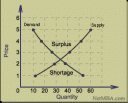Economic scissors: Trial and error
Supply and demand, the economic scissors. This beautiful diagram explains a significant amount about how economists think:
Now from what I understand, when the two curves cross we have equilibrium. This sets a price where demand and supply are equal. When the price is higher we have a surplus of goods, here some of the firms in the industry can’t sell all their produce, and so they cut prices bringing us to equilibrium. When the price is below equilibrium we have a shortage of goods. In this case competing consumers are supposed to bid up the price until we get to equilibrium.
However, in western society we don’t like to bid up the price, we just sit around. The best example I have of this is my daily pie. I want a chicken pie, I go to the store and they only ever have one, and half the time someone else has taken it. Now instead I buy a curry pie. If the store knew that I also wanted a chicken pie they could have put one more in the oven and I would have paid a higher price, and we would both be better off. Instead, they think that I have revealed a preference for curry pies and they keep on cooking them. There is imperfect information here.
How are we supposed to solve the case of the pie, given that western consumers aren’t fond of arguing up the price when there is a shortage. Well I think that firms realise this, and through a process of trial and error they try to increase information, so that they can set the equilibrium price.
The example of this is supermarkets. In a supermarket there always seems to be one type of toilet paper on special. The different manufacturers take turns, lowering there price and sometimes increasing it by more than they dropped it the next week. In this case the firms are trying to discover what the demand curve looks like, they are trying to find out if there is a shortage of their product. Through this process the firm discovers enough information bring us closer to equilibrium, all in the name of maximising profits. How convenient.

